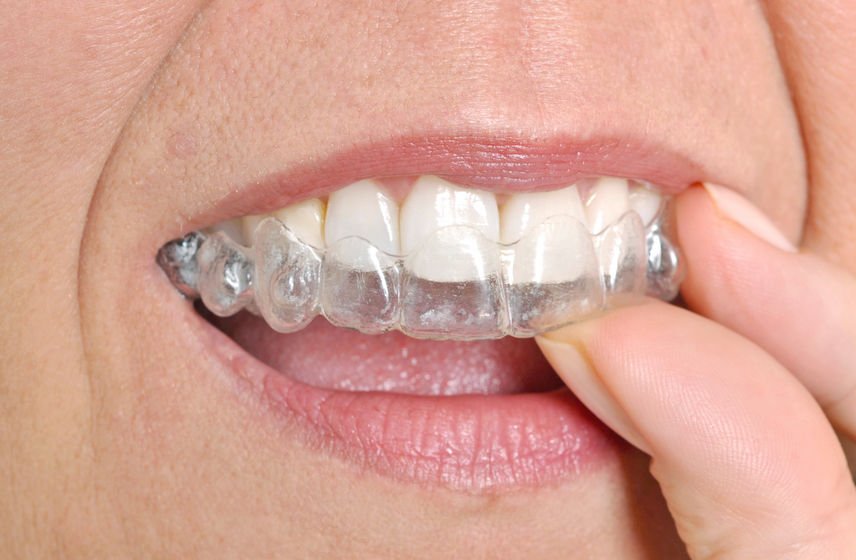What are clear aligners?
Aligners are dental instruments used in orthodontic treatment. They are used to apply gentle pressure on teeth to make them move in a desired direction according to the plan made by the dentist. Traditionally the dentists have been using braces to create this pressure on teeth. To be able to guide the teeth, braces use wires to apply pressure. In clear aligners instead of metal wires, clear plastic is used to create pressure on the teeth to move them.
Like braces, aligners also have to be worn on the teeth for a number of hours for them to have effect on movement of teeth. Aligners need to be worn for 20 hours a day to be effective. Usually, clear aligners are worn for 20 hours a day, for about 3 weeks before they are changed. Each case is different and therefore the length of period for aligners to remain in the mouth is different too. Normally aligners are worn for shorter period than the traditional braces.
Advantages of clear aligners over traditional braces
People who do not want to wear braces but still needs to correct their teeth positions opt for clear aligners. Many people realize the need for a better smile after their teen years, and they feel shy to wear braces in adulthood. These people are offered to choose clear aligners where the patient does not feel self conscious and still get the required treatment.
One of the major advantages of clear aligners is that they are easily removable. The patient can remove them after meals to brush and floss their teeth.
Unlike braces, clear aligners can be washed and kept clean by removing them and put them back on after cleaning.
Sometimes, traditional braces abrase your insides of mouth and may hurt your tongue or dental tissues. Clear aligners are made of plastic and do not have rough edges so there is no question of hurting yourself with them.
Since they are made with plastic, they do not irritate your mouth, cheeks and gums.
Many people have the habit of grinding their teeth. With clear aligners they cannot grind their teeth and prevent damage to their teeth edges.
Clear aligners are sometimes used by patients who have been through the orthodontic treatment already, but require minor change in their teeth position. These patients than opt for clear aligners so that within three weeks they can remove the aligners and get the desired result.
How are aligners made?
Clear aligners use clear thin plastic shells that cover the teeth to move the teeth in desired direction.
When you have decided to wear the clear aligners in consultation with your dentist’s team, your teeth measurements will be taken and virtual model of the same is created. Based on the model a series of aligners will be manufactured, which will be used one after the other, to move the teeth gradually in the direction that is required to correct the position of your teeth.
Depending on the severity of your teeth positions, between 10 to 50 aligners will be made in a series of slight variability which gradually moves the teeth.
It can take more than one series of aligners to get the desired result of moving the teeth which can produce a beautiful smile. The more complex your problem, the more series of aligners will be required. The number of aligner series also is affected by how severe your bite is, how crooked your teeth are and how crowded your teeth are positioned. The consistency of wearing the aligners also affects the time you need to wear the aligners. If you wear them for at least 20 hours per day, and remove them for minimum of hours, your period for wearing aligners will be optimum.
The time also depends on the jawbone resistance to movement of teeth. The more your jawbone resists the movement of teeth, the more time will be required to move the teeth to get the desired result.
How do aligners work?
Aligners use gentle pressure on your teeth. This pressure gets transferred to the roots of your teeth and jaws. The jawbone reacts by moving sockets and the teeth follows. The force applied is tiny and moves from aligner to another aligner, it is not felt and goes smoothly without being uncomfortable.
To apply the pressure, little pressure points are created which are called attachments. These attachments are bonded to the teeth which are coloured like your teeth so that they are not visible. These attachments transfer pressure from the aligners to the teeth to move them. Tiny elastics are also used to transfer the pressure from one to another tooth. Sometimes minor changes are required to fit the teeth perfectly in the aligner, which is usually done in the office with minimal effort.
When you wear them constantly, apart from eating and cleaning the teeth, you can expect the treatment to get over earlier than traditional braces.
Keep in mind
Aligners work well only when you wear them consistently over a period of time. If you put them on and off repeatedly, teeth cannot move in one direction.
Follow the guidelines and time schedule your orthodontist has recommended. If you miss appointments, your time period will lengthen your treatment.
Call your dentist immediately if you notice any abnormality in your aligners.
In rare cases, the jawbone resistance is far greater than the force applied. In such cases consider alternatives.
During and after the treatment it is of vital importance to look after your teeth and follow a strict oral health regime. Brushing after every meal and flossing at least once a day is highly recommended as any kind of bacterial infection can foil the attempt at the treatment. Avoid coloured foods, chewy candy, and red wine as they tend to hinder the treatment and may colour the teeth which will be visible through clear aligners.
The best results can be expected with self discipline while treatment is on.

